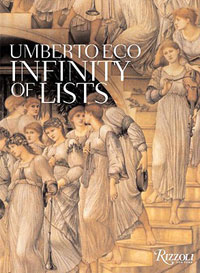Eco Eco

In Boston the gem known as the Isabella Stewart Gardner Museum once hosted the Eye of the Beholder, artist-in-residencies that invited diverse creators such as children's book illustrator Ashley Bryan, performance artist Lee Ming Wei, installation artist Joan Bankemper, photographer Abelardo Morell, and author Sandra Cisneros to spend time at the museum and then share their thoughts with a civilian audience. It's a programmatic gesture many museums adopt, not in the least Paris's Louvre.
For the better part of two years novelist and philosopher/semiotician Umberto Eco (The Name of the Rose and Foucault's Pendulum)--following in the footsteps of artists Robert Badinter, Toni Morrison, Anselm Kiefer, and Pierre Boulez--was in residence at the museum, choosing as his theme of study "the vertigo of lists." And one of the products of his observations is a splendidly illustrated monograph, The Infinity of Lists: An Illustrated Essay (Rizzoli), apparently a sequel to his non-pareill investigations History of Beauty and On Ugliness. This tome is, in essence, a tour through art, literature, and music based on the theme of lists, an investigation of the phenomenon of cataloging and collecting. Additionally, Eco maintains that the impulse to accumulate, to collect, is a reoccurring passion in Western culture.
Eco elaborates:
Mona Lisa
